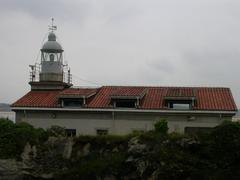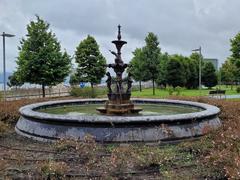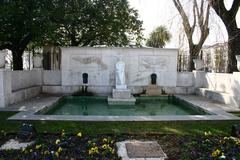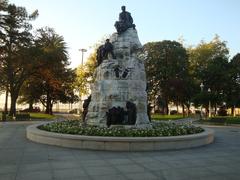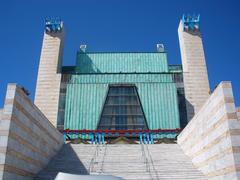Comprehensive Guide to Catedral de Nuestra Señora de la Asunción, Santander, Spain
Date: 18/07/2024
Introduction
The Catedral de Nuestra Señora de la Asunción, commonly known as Santander Cathedral, stands as a monumental testament to the rich historical tapestry and architectural evolution of Santander, Spain. This cathedral is not merely a religious edifice; it is a living museum that encapsulates centuries of artistic, cultural, and spiritual heritage. Originating in the 13th century, the cathedral has undergone numerous transformations, each phase adding to its grandeur and historical significance (Santander City Council). From its Romanesque beginnings to its Gothic expansions and the resilience shown after the devastating fire of 1941, the cathedral’s story is one of endurance and renewal. Whether you are a history enthusiast, an architecture aficionado, or a spiritual seeker, this guide will provide you with comprehensive insights into the cathedral’s background, visitor information, and nearby attractions, ensuring you make the most of your visit to this iconic landmark.
Table of Contents
- Introduction
- Historical Significance and Background
- Architectural Features and Highlights
- Visitor Information
- FAQ
- Conclusion
Historical Significance and Background
Early Beginnings (13th - 18th Century)
The cathedral’s origins can be traced back to the 13th century, a time when Santander was emerging as a significant port town. The initial structure, built upon the ruins of an old Roman settlement, was a modest Romanesque church known as the Abbey of Santander. This abbey, dedicated to St. Emeterius and St. Celedonius, Santander’s patron saints, served as the city’s primary religious center for centuries.
Expansion and Transformation (15th - 18th Century)
As Santander’s prominence grew, so did the need for a grander place of worship. Between the 15th and 18th centuries, the original Romanesque structure underwent significant expansions and renovations. The addition of a Gothic cloister in the 15th century marked a turning point, adding an air of grandeur and sophistication. Further modifications in the following centuries, including the construction of the impressive main façade in the 18th century, solidified the cathedral’s status as a magnificent example of architectural fusion.
Facing Adversity - The Fire of 1941
Tragedy struck in 1941 when a devastating fire swept through Santander, leaving much of the city, including the cathedral, in ruins. The fire, lasting for two days, caused extensive damage to the cathedral’s structure, destroying valuable artwork and historical artifacts. This event marked a dark period for Santander, leaving a void in the city’s heart.
Reconstruction and Resilience (20th Century)
Despite the devastation, the spirit of Santander remained unbroken. The post-fire years saw a remarkable effort to rebuild the cathedral and the city. Renowned architects were commissioned, and meticulous restoration work began, incorporating salvaged elements with new designs. The reconstruction, completed in the latter half of the 20th century, breathed new life into the cathedral, showcasing the city’s resilience and determination.
Architectural Features and Highlights
The Lower Temple - A Journey Back in Time
- Romanesque Origins (12th-13th Centuries): The cathedral’s foundation lies in the Lower Temple, a Romanesque structure built between the 12th and 13th centuries. This area, also known as the crypt or “cripta,” served as the city’s first cathedral. (Santander City Council)
- Architectural Simplicity: The Lower Temple exemplifies Romanesque architecture’s characteristic austerity. Thick walls, barrel vaults, and pointed arches define its spaces, creating an atmosphere of solemn grandeur.
- Historical Significance: This section of the cathedral holds the tomb of Marcelino Menéndez Pelayo, a renowned 19th-century Spanish scholar. His final resting place within the crypt further emphasizes the cathedral’s importance as a historical and cultural landmark.
The Upper Temple - Gothic Ascendancy
- Expansion and Transformation (14th-15th Centuries): The 14th and 15th centuries saw the addition of the Upper Temple, a significant expansion reflecting the prevailing Gothic style. This transformation turned the modest Romanesque structure into a grander, more elaborate place of worship.
- Gothic Hallmarks: The Upper Temple features elements characteristic of Gothic architecture, including:
- Soaring Heights: High vaulted ceilings create a sense of verticality, drawing the eye upwards towards the heavens.
- Luminous Interior: Large stained-glass windows, a hallmark of Gothic architecture, flood the interior with natural light, creating a vibrant and ethereal atmosphere.
- Slender Columns: Graceful, slender columns support the weight of the vaulted ceilings, a departure from the massive pillars of the Romanesque period.
The Cloister - A Tranquil Oasis
- A Serene Retreat (15th Century): Constructed in the 15th century, the cloister provides a peaceful respite from the bustling city outside. Its square layout, surrounded by covered walkways, offers a sense of tranquility and seclusion.
- Architectural Harmony: The cloister’s design echoes the Gothic style of the Upper Temple, creating a harmonious architectural dialogue between the two spaces.
- Intricate Details: The cloister’s beauty lies in its details:
- Delicate Tracery: Intricate stonework adorns the arches and windows, showcasing the craftsmanship of the period.
- Central Garden: A serene garden at the heart of the cloister provides a space for contemplation and reflection.
The Tower of San Miguel - A Beacon Over Santander
- A Commanding Presence (14th Century): Dating back to the 14th century, the Tower of San Miguel, or “Torre de San Miguel,” stands as a prominent landmark in Santander’s skyline.
- Gothic Splendor: The tower’s design exemplifies Gothic architectural principles, with its pointed arches, decorative elements, and upward-reaching structure.
- Panoramic Views: Today, the tower is open to the public, offering breathtaking panoramic views of the city, the bay, and the Cantabrian Sea.
Architectural Fusion - A Tapestry of Styles
- Renaissance and Baroque Influences: While predominantly Romanesque and Gothic, the cathedral also features subtle Renaissance and Baroque influences, particularly in its decorative elements. These additions, incorporated over the centuries, contribute to the building’s unique and layered aesthetic.
- A Continuous Evolution: The Catedral de Nuestra Señora de la Asunción stands as a testament to the evolution of architectural styles over time. Its blend of Romanesque, Gothic, Renaissance, and Baroque elements creates a captivating visual narrative of Santander’s history.
Visitor Information
Santander Cathedral Visiting Hours
The cathedral is open to visitors daily, with the following hours:
- Monday to Saturday: 10:00 AM - 7:30 PM
- Sunday and public holidays: 10:00 AM - 1:30 PM and 4:30 PM - 7:30 PM
Santander Cathedral Tickets
Tickets can be purchased at the entrance or online. Prices are as follows:
- Adults: €5
- Seniors (65+): €3
- Students: €2
- Children under 12: Free
Travel Tips
- Best Time to Visit: Early morning or late afternoon to avoid crowds.
- Dress Code: Modest attire is recommended as it is a place of worship.
- Photography: Allowed in most areas, but check for any restrictions.
Nearby Attractions
While visiting the Santander Cathedral, consider exploring these nearby attractions:
- Plaza Porticada: A historic square perfect for a leisurely stroll.
- Centro Botín: A modern art center offering exhibitions and cultural events.
- Palacio de la Magdalena: A stunning royal palace with guided tours available.
FAQ
Q: What are the Santander Cathedral visiting hours? A: The cathedral is open Monday to Saturday from 10:00 AM to 7:30 PM, and on Sundays and public holidays from 10:00 AM to 1:30 PM and 4:30 PM to 7:30 PM.
Q: How much are the tickets for Santander Cathedral? A: Adult tickets are €5, seniors (65+) are €3, students are €2, and children under 12 can enter for free.
Q: Are there any guided tours available? A: Yes, guided tours are available and can be booked in advance.
Q: Is photography allowed inside the cathedral? A: Photography is generally allowed, but please check for any specific restrictions.
Conclusion
The Catedral de Nuestra Señora de la Asunción stands as a symbol of Santander’s enduring spirit and rich history. From its early beginnings to its modern-day significance, the cathedral offers a unique glimpse into the city’s past and present. Whether you’re visiting for its historical value, architectural beauty, or spiritual significance, the Santander Cathedral is a must-see destination.
For more information and updates on visiting Santander Cathedral, visit the official website or follow us on social media. Don’t forget to check out our mobile app Audiala for exclusive content and travel tips!
References
- Santander City Council
- Visiting Santander Cathedral - History, Tickets, and Tips, 2024, Author source
- Visiting Catedral de Nuestra Señora de la Asunción - History, Tickets, and Highlights in Santander, 2024, Author source
- Visiting Catedral de Nuestra Señora de la Asunción - Hours, Tickets, and Nearby Attractions in Santander, 2024, Author source
